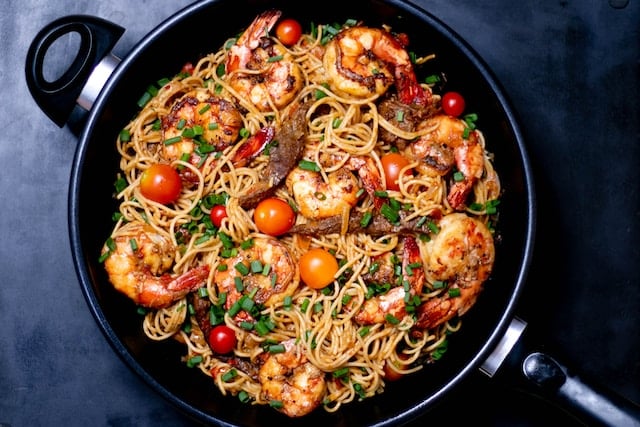How Can You Elevate a Traditional Irish Soda Bread with Artisanal Flours?

As a crowd-pleaser, Irish soda bread’s rich history and rustic aesthetic make it an all-time favorite for bakers across the globe. It’s a quick bread recipe that doesn’t require the use of yeast or a long proofing time. Instead, it relies on the chemical reactions between baking soda, buttermilk, and heat to rise. In this guide, we’ll take this classic loaf and elevate it using artisanal flour. We’ll explore the delicate art of handling these special flours, and how they can transform your soda bread from good to extraordinary.
How Artisanal Flours Can Transform Your Soda Bread Recipe
Let’s kick off with an introduction to the role of artisanal flours in the baking process.
A voir aussi : What Techniques Can You Use to Make a Luxurious Tiramisu with Mascarpone?
Flour is much more than an ingredient to hold a bread together. It carries a significant role in defining the texture, flavor, and color of the loaf. Unlike their commercial counterparts, artisanal flours are often milled from heritage grains, offering a more robust flavor profile and a denser, heartier texture.
When used in a soda bread recipe, these flours can add a depth of flavor to the bread that complements perfectly the tanginess of buttermilk, the richness of butter, and the sharpness of cheese.
Avez-vous vu cela : Can You Create a Gourmet Cider-Braised Pork Belly with Apple Compote?
Choosing the Right Artisanal Flour For Your Soda Bread
Picking the perfect artisanal flour for your soda bread requires understanding the fundamental differences among these flours.
Rye flour is a popular choice among bakers seeking a deep and earthy flavor in their soda bread. This flour pairs well with strong cheeses and robust ingredients. However, it can make the dough a bit sticky to handle and requires careful mixing.
Spelt is another excellent choice for a nutty flavor. Well-known for its nutty flavor, spelt flour is easier to handle and doesn’t require as much kneading time as wheat flours.
Lastly, consider using whole wheat artisanal flour for its high fiber content and rich, robust flavor.
Perfecting the Art of Mixing Your Soda Bread Dough
Now that you have chosen your artisanal flour, it’s time to perfect the art of mixing your soda bread dough.
The key to a successful loaf lies in the gentle handling of the dough. Since soda bread doesn’t require yeast, overmixing can lead to a dense and heavy loaf.
Start the process by measuring your dry ingredients: flour, baking soda, and salt. Then, make a well in the center and slowly add in the buttermilk while stirring minimally. You’ll want to mix it just enough to incorporate the ingredients.
Next, add your butter and cheeses. For a sharper flavor, choose a mature cheese variety that will stand up to the robust flavor of the artisanal flour.
Baking Your Artisanal Soda Bread
The final step in elevating your traditional Irish soda bread is baking it.
Preheat your oven to 425°F (220°C) and prepare your baking sheet by lightly dusting it with flour. Shape your dough into a round loaf, ensuring not to overwork it. Cut a cross into the top to help the bread bake evenly.
Bake your bread for about 30 minutes, or until it has a beautiful golden brown crust and sounds hollow when you tap the bottom. Remember that baking times will vary depending on the type of artisanal flour you used and the actual temperature of your oven.
Remember, soda bread is best enjoyed fresh out of the oven, slathered in butter, or dipped into a hearty stew.
Experimenting With Different Recipes
The beauty of baking is in the experimentation. Don’t be afraid to try different recipes and add-ons for your soda bread.
Consider adding some dried fruits, nuts or seeds to your dough for an extra dimension of flavor and texture.
Similarly, play around with different cheese varieties and see how they affect the final taste of the loaf. A sharp cheddar might give a different taste from a milder mozzarella or a creamy brie.
In the end, the choice of flour, choice of cheese, and even the type of buttermilk you use, will all play a role in the final flavor, texture, and appearance of your loaf. So, go ahead and experiment until you find the perfect combination that satisfies your palate.
Remember, the key to perfecting any bread recipe, including soda bread, lies in understanding the ingredients and how they interact with each other. Therefore, don’t be afraid to dive into the world of artisanal flours and see how they can elevate your next loaf of Irish soda bread.
Exploring Other Baking Elements of Irish Soda Bread
Having discussed the role of artisanal flours in enhancing your soda bread, let’s delve into other aspects of the baking process that contribute to the final result.
The success of an Irish soda bread recipe doesn’t merely rely on the type of flour used. Other elements, like baking soda and baking powder, play equally crucial roles in the formation of the bread. Baking soda, when combined with an acid like buttermilk, creates a chemical reaction that helps the bread rise. If your recipe doesn’t include an acid, then a combination of both baking powder and baking soda will do the trick.
The baking time also plays a vital role. Most recipes suggest a baking time of around 30 minutes, but this may vary depending on your oven’s temperature accuracy and the type of artisanal flour used. It’s essential to keep a close eye on your bread during baking to avoid over-browning.
Don’t forget the importance of your baking utensils. Using a cast iron skillet or a baking sheet lined with parchment paper can considerably enhance the texture and flavor of your loaf. The cast iron skillet, in particular, helps to create a beautiful, crispy crust that’s a delight to bite into.
Lastly, remember that your ingredients should be at room temperature before you start. This ensures they mix properly and react as needed during baking.
Conclusion: Perfecting Your Elevated Traditional Irish Soda Bread Recipe
Irish soda bread is a simple, rustic, and versatile loaf that has won the hearts of many over centuries. By incorporating artisanal flours, you can create a version that’s not only healthier but also richer in flavor and texture.
Whether you prefer spelt for its nutty taste, rye for its earthiness, or whole wheat for its robustness, the choice is yours. Just ensure to handle the dough gently, baking it at the right temperature and time.
Don’t forget the fun in experimentation – different cheese types, dried fruits, nuts or seeds, all can add an exciting twist to your soda bread recipe.
In essence, the journey of baking a perfect loaf of Irish soda bread involves understanding each ingredient’s role and how they interact. So, as you venture into the world of baking soda bread with artisanal flours, remember that patience, practice, and a love for baking are your best companions. Happy baking!
